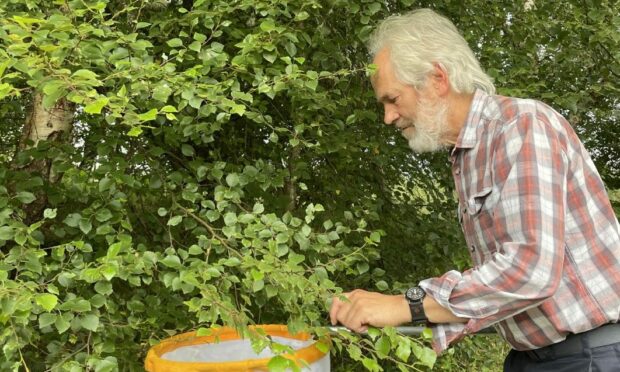When flying insects are providing a hundred thousand welcomes to the Highlands, you don’t tend to consider their family background.
That’s best left to Ian Strachan, who has spent five years on a microscope marathon, and is not done yet.
The dogged diperist – someone who collects and studies flies – has to date identified 946 species of mostly flying insects in Loch Arkaig pine forest in Lochaber.
He estimates he is only two thirds of the way through his epic study which began in 2018.
Study shows forest’s biodiversity
“The minute you say West Highland insects, most people think of the dreaded biting midge,” he said.
“Many will be amazed just how small a component those and other biters like clegs are in the scheme of things.
“There is much more buzzing around at Loch Arkaig than biting midges, though they do have a particular talent for making their presence felt.”
The study is thought to be the most thorough ever conducted in a Western pinewood in Scotland’s rainforest zone, and shows the habitat’s amazing biodiversity.
Ian took his first samples from two locations in the forest using Malaise traps, contraptions that funnel flying insects into a jar of preservative alcohol.
He then started the laborious task of separating out and identifying individual specimens under a microscope.
By 2020 he had identified 316 species, including two fungus gnats entirely new to the UK.
Boletina gusakovae is usually found in Finland and Russia and Mycetophila idonea in Estonia, Poland, Slovakia, Georgia and Luxembourg.
His total from the original samples has now reached 650.
In addition, further samples were taken in 2021 which another a further 219 species to the list.
The 869 flying insects, includes midges, dance flies, hoverflies, fungus gnats, barkflies, mayflies, stoneflies, dragonflies, alderflies and caddis flies.
There are also 77 non-flying species, mostly spiders but also millipedes, centipedes, woodlice, springtails and ticks.
Rare species
At least 50 of the species identified so far are considered rare or scarce in Britain, with almost a third included on national Red Lists as vulnerable or threatened.
The Malaise trap samples have been sorted to at least family level.
But individual insects sometimes sit in jars at the National Museum of Scotland waiting until the right expert can be found to name their species.
Specimens of fairy wasps have been sent to the Natural History Museum in London and are awaiting identification.
Other specialists from across the country have also been asked to help, including members of the Malloch Society (Scottish fly enthusiasts).
In a few cases he has sought experts from abroad, including Italy and Canada.
Some of Ian’s most exciting finds have been rare dance flies, including a Scottish first.
He said: “This has been a really challenging but satisfying process, investigating the remarkable insect diversity of these woodlands.
“My findings are attracting a lot of interest from other entomologists and ecologists.
“I am not aware of a more exhaustive study ever having been carried out in a Western pinewood.”
Loch Arkaig pine forest was bought by Woodland Trust Scotland and local group Arkaig Community Forest in 2016.
Funding raised by players of People’s Postcode Lottery contributed to buying the site and its ongoing restoration work.
Area known also known for Commandos and Harry Potter
British Commandos and Allied Special Forces, including the Free French, trained at Loch Arkaig during the Second World War.
The loch was also a filming location for a sequence in Harry Potter and the Deathly Hallows.
But filming on the loch shore had to be cut short because of the fierce midge onslaught.
Various surveys were commissioned to assess what was in the wood – including birds, fungi and lichens.
Ian, from Roy Bridge, was commissioned to survey the insect life.
Laura Chow, head of charities at People’s Postcode Lottery, said: “This is a quite remarkable piece of work and we applaud Ian Strachan’s extraordinary tenacity.
“Flies might not seem as glamorous an area to work in as, say, birds of prey or wildcats, but they are just as important.
“These findings will help us understand the amazing biodiversity of these woods and will guide restoration efforts in the coming years.
“We’re delighted support from our players continues to assist with this.”
Ian is giving a talk about his findings to the Dipterists’ Forum in November.




Conversation